Intuitive and mobile
Softphone
Want to work from anywhere? A softphone will let you make phone calls from your computer or mobile device through an app. No desk phones needed. Sign up for a 14-day free trial to see how Dialpad's AI-powered communications platform works! It takes just a few minutes and you'll be set up with a virtual number too.
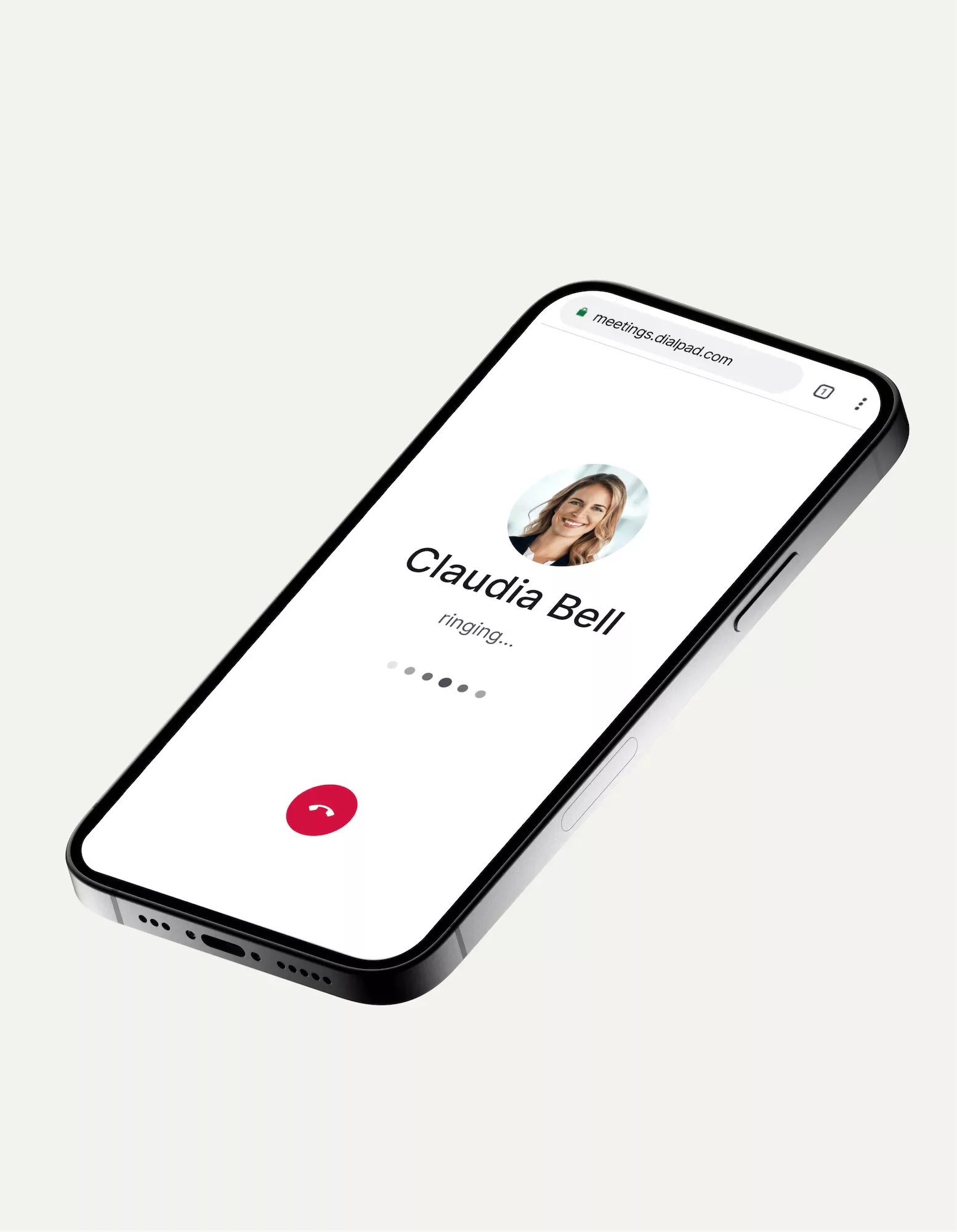
Want to work from anywhere? Most likely, you'll need to make phone calls, send instant messages, and have video meetings over the Internet.
That means you need a cloud phone system or collaboration platform that lets you make VoIP calls (aka. Voice over Internet Protocol) using a desktop or mobile app. These are also called softphones or softphone apps, and they're pretty much essential for any remote or hybrid team that needs to stay in touch with clients, prospects, and teammates outside the office.
Let's learn more about how softphone apps work, what to look for in one, and more.
What is a softphone?
Softphones are basically telephony software applications that you can download and install on any Internet-enabled device in order to make telephone calls on the go.
The app should have a dial pad (like the one you see when making regular phone calls on your smartphone)—the main difference is that instead of using your mobile phone network to make phone calls, you’ll be using VoIP technology and the Internet to make and take voice calls.
Dialpad, for instance, lets you make phone calls via carrier calling or Wi-Fi calling, from your computer, cell phone, or tablet via the app:

Besides this fundamental difference, softphones usually also come with a wide range of additional features, depending on your VoIP service vendor.
For example, Dialpad’s mobile app comes with a range of advanced softphone features like call recording, voicemail transcription, and more. You can even flip a call seamlessly from your cell phone to your computer (or vice versa) without interrupting the conversation:
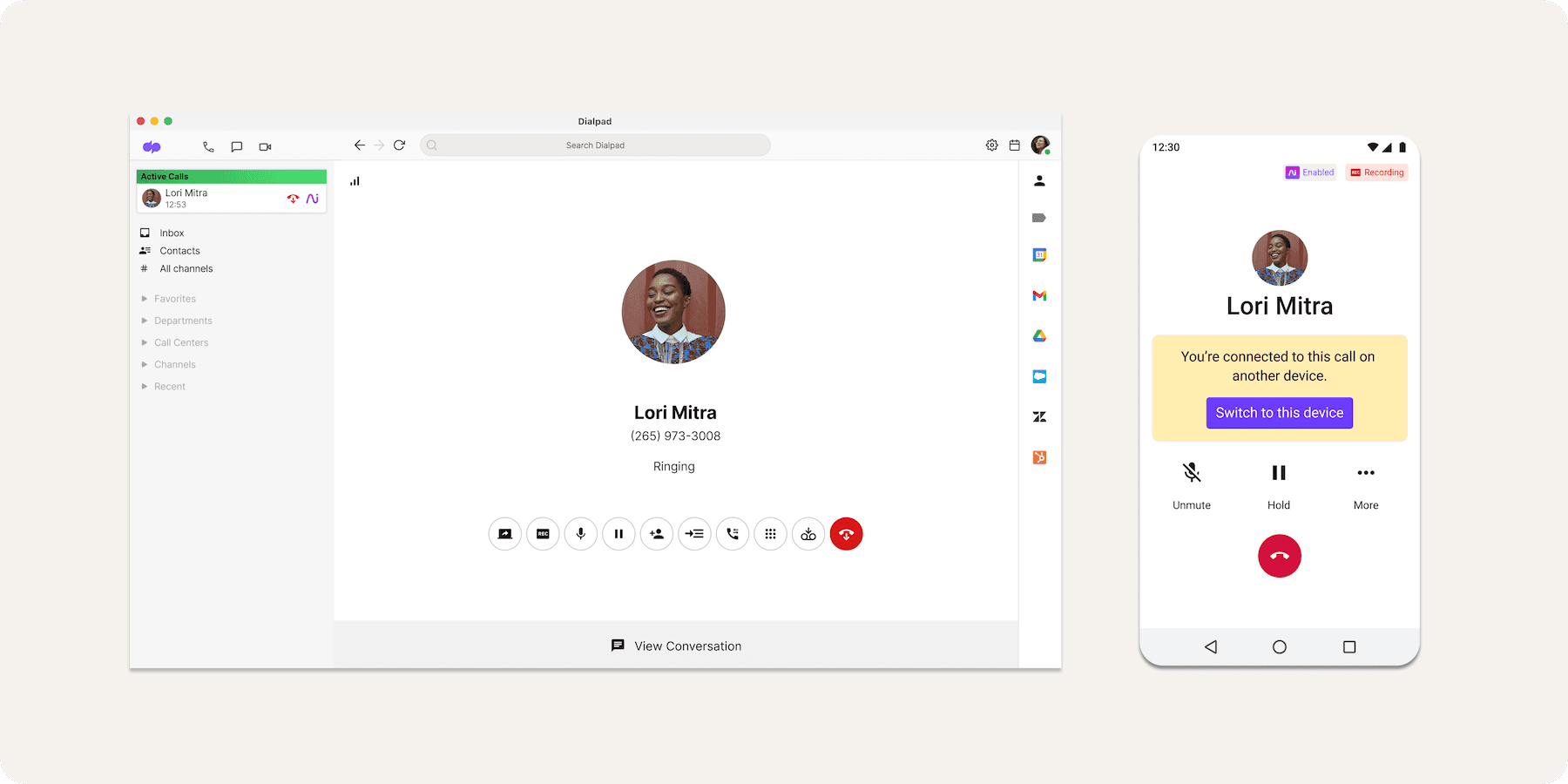
This is a huge advantage over traditional PBX phones and landlines, and makes softphone technology much more versatile and robust in functionality compared to your typical office phones.
👉 Dialpad tip:
Some VoIP providers don’t have mobile apps at all, or have only PC or Mac apps, or have very scaled down versions of their full platform if you’re just using the iOS or Android app. It really varies. Make sure to try these out during the free trial if you’re seriously considering a particular VoIP provider!
How does a softphone work?
For the most part, softphones work very much like any other phone. You open the desktop or mobile app, dial a phone number (or select someone from the contact list) on your cell phone or computer, wait to be connected, and that's it!
(The only difference is that, instead of dialing a physical keypad, you’ll be dialing a virtual one from an app on your smartphone or computer.)
With a good VoIP or softphone provider, you'll still get all of the traditional phone functionality like call forwarding, call waiting, and call transfer. And in many cases, a softphone makes setting these things up much easier. For example, Dialpad's softphone app lets you adjust all these settings right in your online dashboard without having to get in touch with a support team or wait days (or weeks) for changes to be implemented.
Want to add a call forwarding number? Just log into Dialpad:
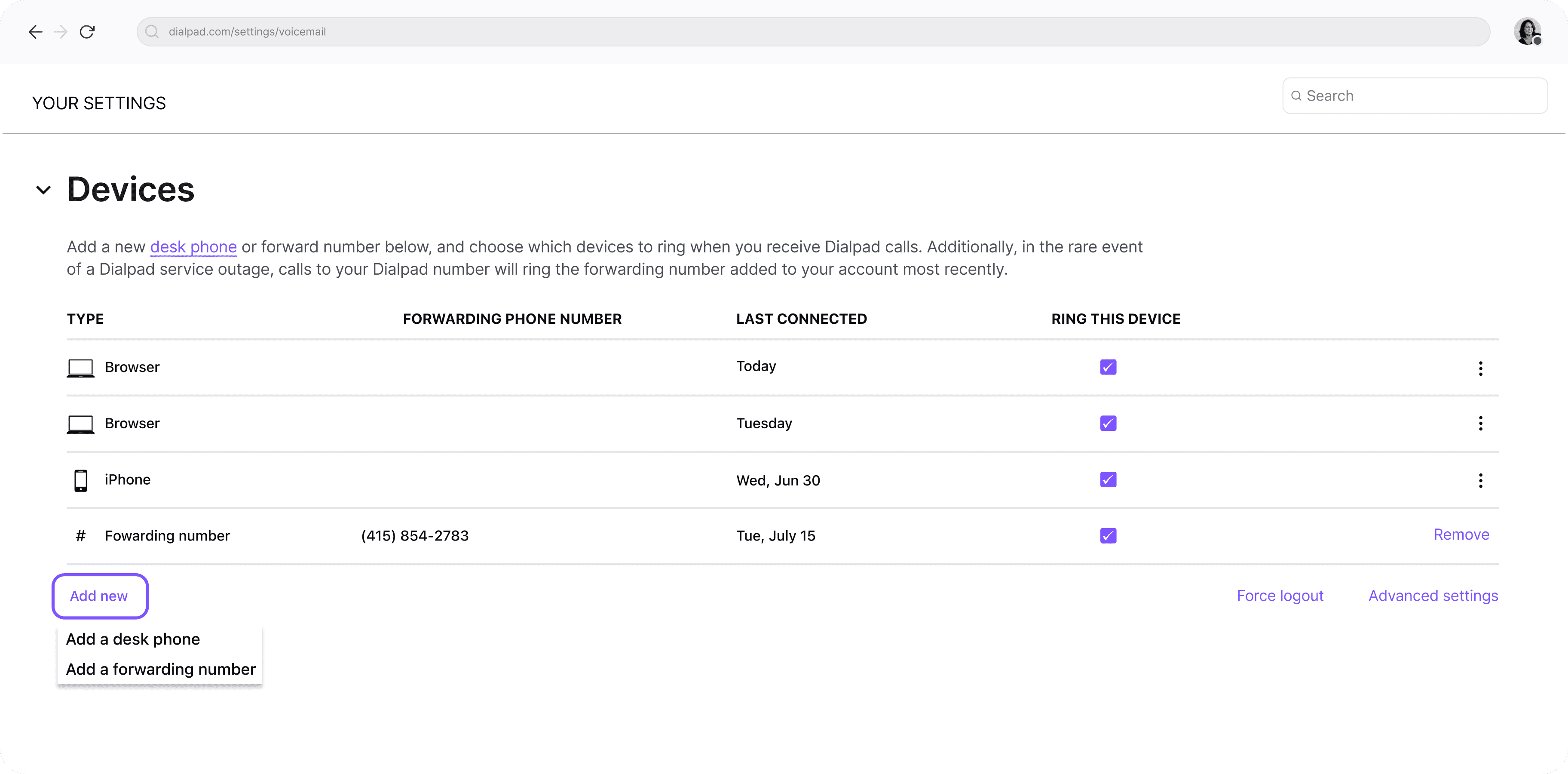
And to go one step further, you can even use Dialpad's softphone app on your web browser—no downloads needed!
In terms of how you go about getting one, softphone apps typically come included as part of a VoIP phone system, which you can sign up on a monthly or annual plan for with a software service provider. For example, here's Dialpad's phone system pricing—even the most basic plan includes unlimited calling in your country, the US, and Canada:
What are the benefits of using a softphone?
Softphones can be very useful for businesses—specifically businesses with remote and hybrid teams—for a few reasons, and they do have a few advantages compared to traditional desk phones.
They’re more cost-efficient — If you work at a small business, making VoIP calls on a softphone is usually much cheaper since you don’t need to pay for expensive hardware (and international calling tends to be cheaper too).
You save on equipment and maintenance — And on that note, you also don’t need in-house wiring or PBX servers. Your service provider takes care of everything, from support to product updates. All you need is to make sure you have the bandwidth to make those calls over the Internet.
It’s accessible on any device, from anywhere — If you choose a good provider, their softphone app should work across different desktop and mobile devices, as long as you have a good Internet connection. But this is helpful, not only for your own employees who might be using different devices, but also for clients and prospects who may need to join your video conferences. (You can’t control whether or not they’ll download an app either, so a browser-based softphone app is even better.)
👀 Moving your team to remote or hybrid work?
Grab the Hybrid Work Playbook, which includes real-life case studies and breaks down all things hybrid + remote, from building and sustaining a hybrid workforce to equipping your team for success.
Softphones vs. desk phones (or hard-phones): How to know which one you need
No matter how much we all like to say that everyone’s going remote, the fact is that some businesses and industries do still need hard-phones (though this is becoming less and less common).
Here are a few questions to ask if you’re wondering whether you should go with softphones, hard-phones—or both!
What remote capabilities do you need?
If your team (or part of your team) needs to be in the office, then you may find it useful to have a physical VoIP phone or two. Otherwise, if everyone’s remote, you probably just need a good softphone.
For example, Joy, the receptionist at global ad agency Mono, forwards calls from her desk to her cell phone when she’s in meetings—a perfect example of how a business can use both softphones and hard-phones in harmony.
How much are you prepared to pay in upfront costs?
One of the big advantages of softphones is that they reduce upfront costs by removing the need for desk phones and other hardware—which by extension also helps you save on complicated onboarding and startup costs.
This initial capital investment can be high, not to mention the money required to maintain an in-house telephony system.
Would you like to be able to call, text, and have video meetings from one app?
Finally, if you’re already using all these different business communications channels, then a softphone can help you consolidate them all into one app.
With a traditional telephony setup, you’d need a dedicated phone line, plus different apps for messaging, video conferencing, and more.
Now, you don’t have to do that anymore, with UCaaS (Unified Communications as a Service) and other collaboration solutions. For example, with Dialpad’s app, you can talk, message, and meet (and even manage a call center if you wanted to—since Dialpad's AI-powered customer engagement features are fully integrated into that same app):

What specific features should a softphone have?
Remember, there are many different VoIP providers out there, many of which offer a softphone feature with their services. But the quality of these apps varies greatly! Here are a few examples of what to look for:
Video conferencing, messaging, and calling
Most people today aren’t just communicating with coworkers and clients through phone calls. They have conference calls, they do video calling, they text… If this is the case for your team, then make sure your softphone supports video calls, conferencing, and texting.
Not all softphone apps come with these, so make sure to try the features out in a sales demo or free trial. For example, Dialpad comes with a video conferencing feature that has robust security controls. Hosts can mute participants, remove unwanted guests, and even admit people into the meeting from a virtual waiting room:

Fun fact: If you have a contact center or call center, Dialpad has a fully integrated cloud contact center platform that works in the same app too.
Presence statuses
For teams using softphones as part of their collaborative work, user presence and custom status features can be helpful because they let your coworkers know if you’re not available or on a call. With Dialpad, for example, you can choose your presence settings from these options:
Available
On a Dialpad AI Meetings call
On a phone call
Do not disturb.
That way, you can contact people when you know they’ll be available or switch to a more appropriate medium like instant messaging.
Have a busy day or just doing deep work and don't want to be disturbed? In Dialpad, you can click “set your status” at the top of your avatar and choose "Do Not Disturb":
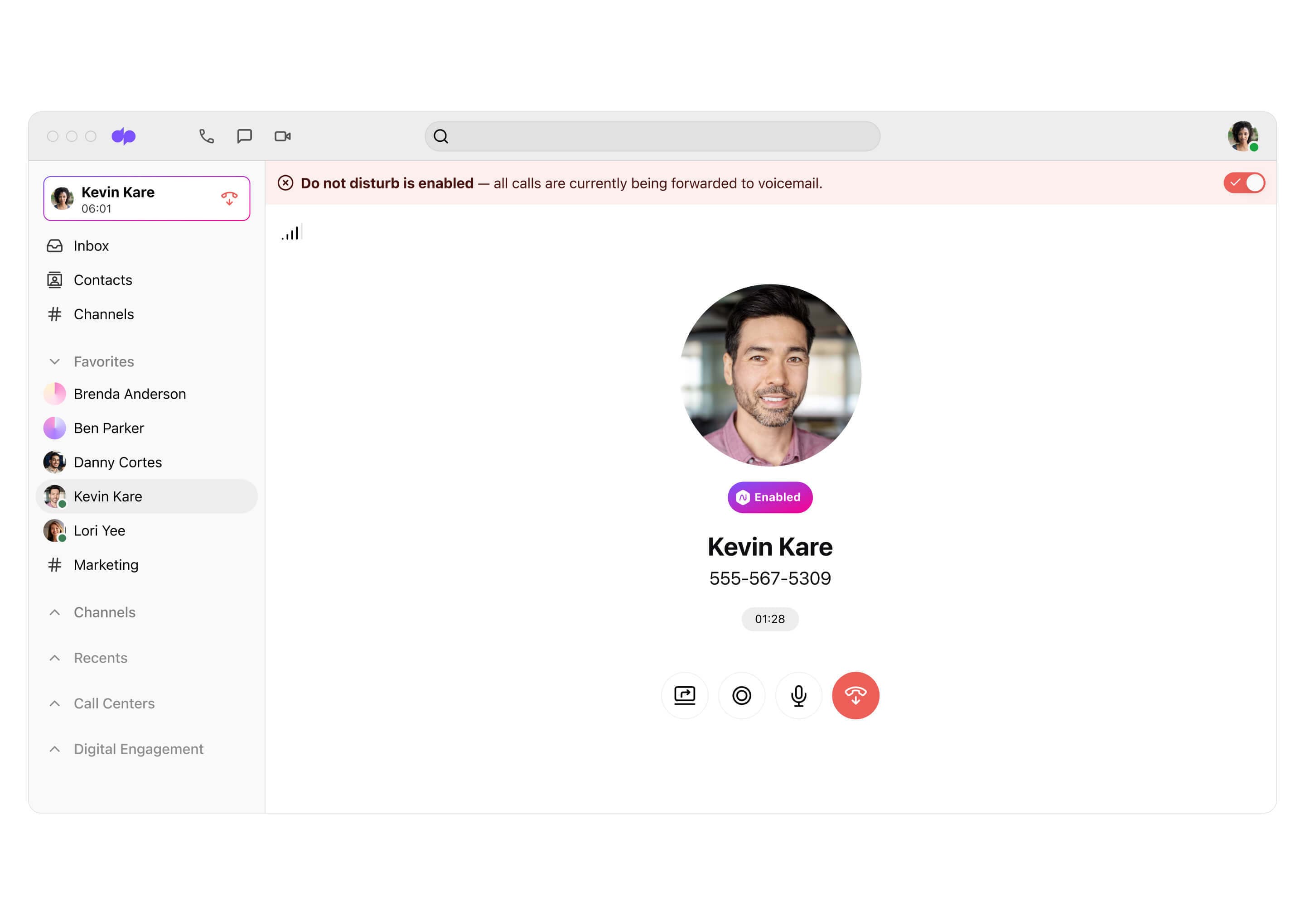
Voicemail
This is sometimes overlooked, but make sure your softphone app has a good voicemail feature. Namely, it should be easy to change or upload a voicemail greeting, listen to voicemail messages—and ideally, there should be a visual voicemail option.
This is useful because you can't take every incoming call when you're busy, and if you're in meetings all day, you probably can't listen to voicemail messages whenever you want. A voicemail transcription feature lets you read your messages, which is much easier to do! Here's how it looks in Dialpad, for example:
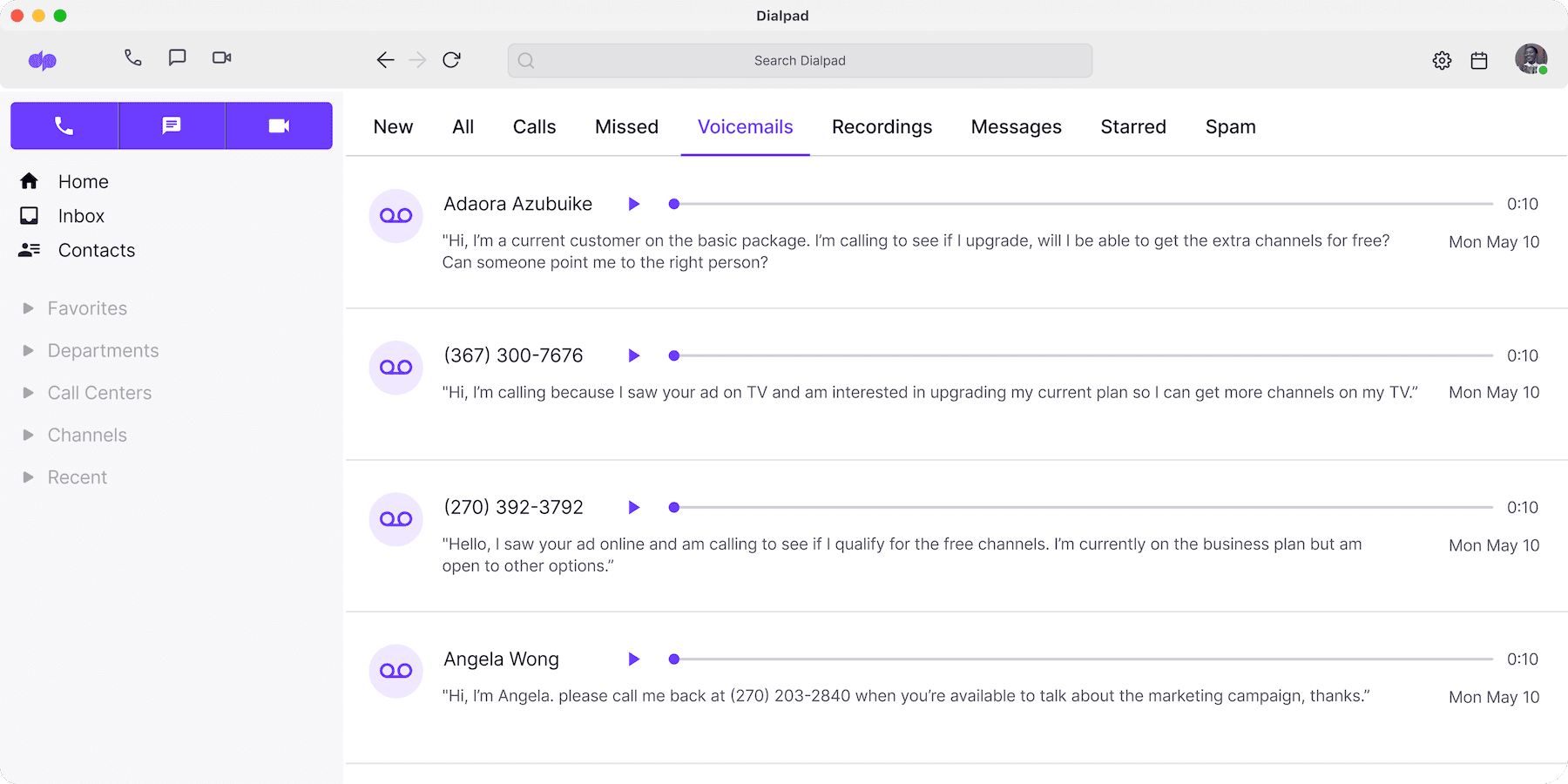
Integrations with your favorite tools
Whether it's a CRM like Salesforce or HubSpot, or your everyday productivity tools like Google Workspace or Microsoft 365, a good unified communications or softphone service provider should integrate with them. It may seem like a small thing, but being able make phone calls from directly inside Salesforce, and having your meeting invites auto-populate with a meeting link or dial-in info can really add up over time.
For instance, Dialpad can integrate a CTI dialer in Salesforce and even auto-log calls and activities too:
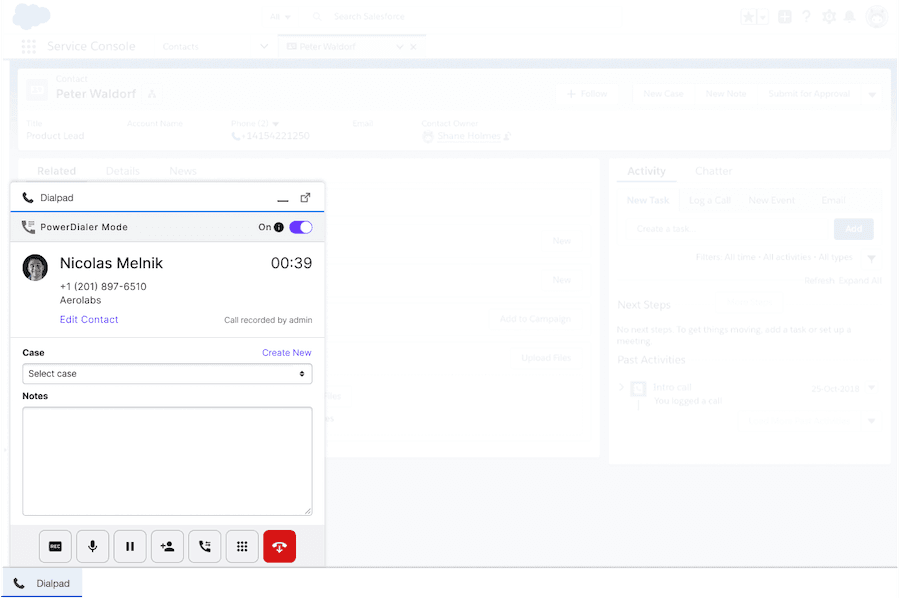
Want a softphone that's more than a phone?
Dialpad isn't just a phone system. It's a robust AI-powered communications platform that lets you have video conferences and sent instant + SMS/MMS messages—in addition to making phone calls from anywhere. Book a demo or, take a self-guided interactive tour of the softphone app!
Things to look for in a softphone provider
If you're looking for the best softphone software, the thing to keep in mind is that these apps are almost always a feature that comes included when you sign up with a communications platform or business phone system.
These platforms often have built-in VoIP phone systems and video conferencing features, and you're not just buying the softphone app itself—you're also investing in this overall provider.
We looked at features in the app earlier, now here's what to consider as you're comparing softphone providers.
Sufficient phone lines
Make sure your chosen phone service can meet your anticipated call volumes. Ask yourself how many lines you need now, and how many you might need in the near future. Remember, you’ll want your softphone system to be able to scale up (or down) with your business over time. ClassPass, for instance, needed to spin up new offices around the world and scale up quickly—here's how they made sure all their new employees got phone numbers right away.
With Dialpad, you can easily manage phone lines and add phone numbers, right in your online dashboard:
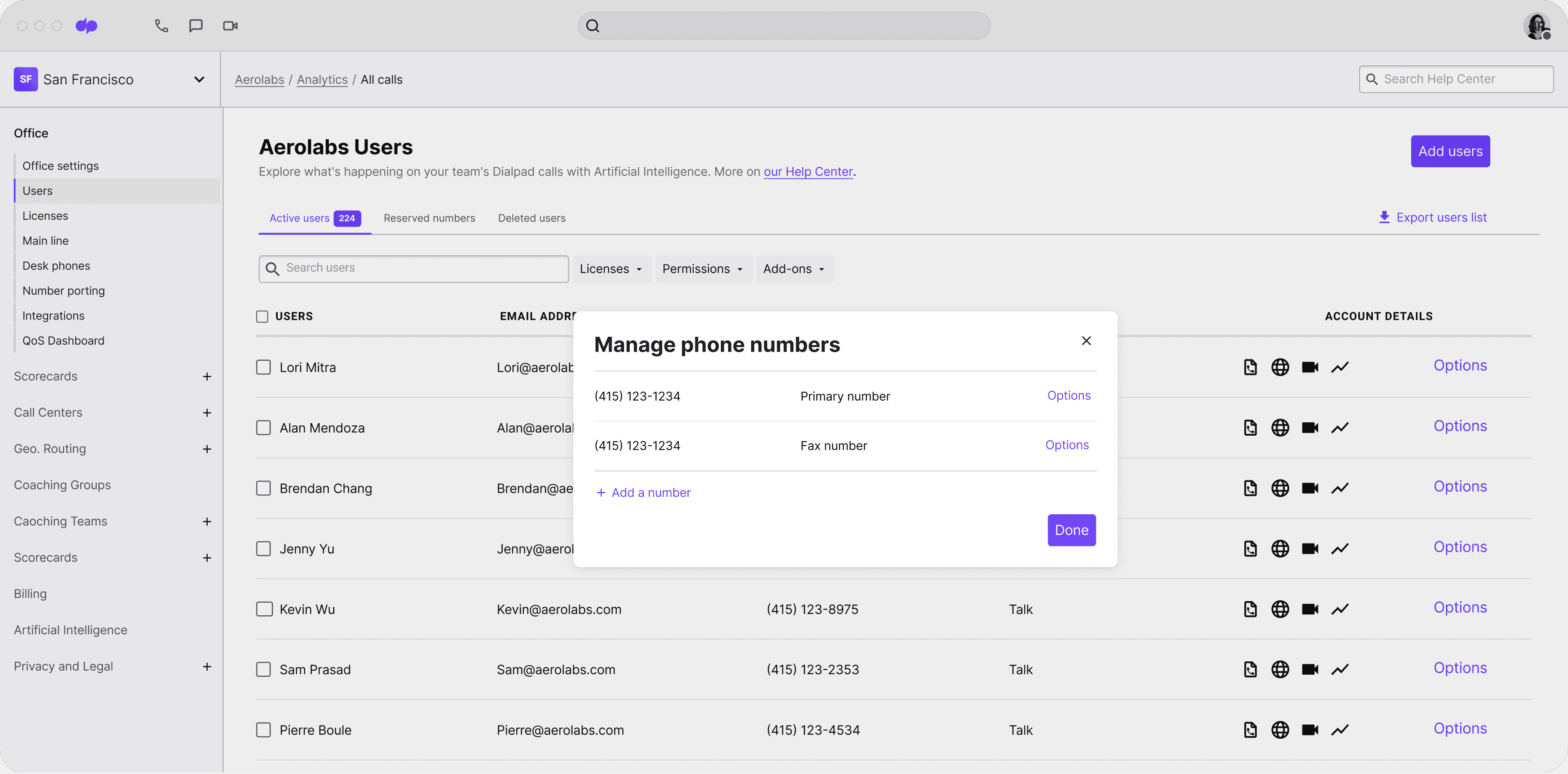
Robust security standards
It’s a common misconception that softphones are less secure than traditional phones. In reality, so long as you pick a service plan with a good security standard then you’ll be well (if not even better) protected.
Regardless, this is a key point—you're having important conversations with customers and prospects using your softphone app, and that counts as data that you need to protect. If you're in a highly regulated industry like healthcare or insurance, make sure your provider is HIPAA-compliant, has encryption features, and anything else that your industry requires.
Excellent customer support
This is another item that businesses tend to miss when they're looking at VoIP service providers or communications platforms. Not everyone offers the same level or type of customer support! Some providers provide US-only support, while others don't have any form of support at all unless you're at one of the highest pricing tiers. Make sure to check the fine print. (Here's more on Dialpad's tech support, if you're interested.)
Choosing softphone service providers that fit your needs: 4 things to keep in mind
1. The devices and operating systems you need to support
Start by taking a look at your existing hardware—some softphone apps are only compatible with specific devices (e.g. smartphones) or operating systems (e.g. Microsoft Windows). Your business setup will have a big influence on your softphone choice. For example, Dialpad's desktop and mobile app works across iOS, Mac, PC, and Android. (And also works on web browsers, no downloads needed.)
2. The specific features you need
Outside of making and receiving calls, consider what else you need your softphone to do. Do you need conferencing features, voicemail, or call transfer? Look at specific features—and more importantly, how easy they are to use—to make sure you’re making the right choice.
Always try the free trials and get the demos. Otherwise, it's almost impossible to really get a feel for how well the softphone app is actually designed.
3. Pricing structure and payment options
While VoIP softphones are usually cost-effective, it’s still important to pay attention to the fine print. Beyond just looking at a provider’s pricing tiers, also look at their customer support (do they have worldwide support?) and add-on features. (Do they charge extra for functionality that should come included?)
4. Local and international coverage
If you make a lot of overseas calls, you should check if your provider can support your long-distance calling needs too. Since you’ll need both local and international numbers, it will help if you can get all your numbers from your provider. You should also check for call quality—can you make calls from around the world without jitter or the audio breaking up?
Fun fact:
Dialpad's unique dual cloud architecture and global voice network are designed specifically to give you excellent call quality around the world. Ask us about it!
An AI-powered softphone solution that gives you more than just phone calls
Today, there are a ton of VoIP softphone providers for businesses to choose from. With Dialpad, you get all the crucial functionalities you’d expect from a modern softphone. But beyond unlimited calling in the US and Canada, it also has robust video conferencing features, an easy-to-use voicemail feature that even transcribes voicemails—in real time—and much, much more.
Need to flip a call between your computer and cell phone because you have to step away from your desk? You can do that too. And, if you’re using a CRM solution or productivity tools like Google Workspace, the softphone app has a wide range of integrations with all of these apps. Try it out now for free!
Looking for an easy-to-use softphone app?
Dialpad gives you fully unified communications—phone calls, instant + SMS/MMS messaging, video conferencing, and even call center features—all from an intuitive softphone app. Sign up for a 14-day free trial to try it out. It takes a few minutes, and you'll be set up with a virtual number too!
